How Do the Young Perceive Urban Parks? A Study on Young Adults’ Landscape Preferences and Health Benefits in Urban Parks Based on the Landscape Perception Model
Abstract
1. Introduction
1.1. Previous Research on Youth and Park Perception
1.2. Spatial Perception and Landscape Perception
1.3. Development of Landscape Perception Model
1.3.1. Landscape
1.3.2. Human
1.3.3. Human–Landscape Interactions
1.4. Study Focus
- Which landscapes are most popular with young adults, and what are the characteristics of urban parks as perceived by this age group?
- What health benefits do urban parks bring to young adults?
2. Materials and Methods
2.1. Study Area
2.2. Data Collection
- We explored various sensations in the park by asking participants to record their first feelings upon arrival.
- We learned about perceptions of the landscape in the park by leading participants to keep track of the landscape elements, attractions, people, and activities after taking a tour of the park.
- We collected emotions, feelings, and retrospective reflections evoked in the park by asking what participants liked or disliked in the park in addition to their reflections.
2.3. Data Analysis
3. Findings
3.1. What Is the Overall Impression of Young People in the Park?
3.2. What Kinds of Landscape Do Young Adults Concerned about?
3.2.1. Environmental Feature
3.2.2. Crowds
A little girl was catching fish with a net under the weeds by the river, while her grandmother stood by and held her hand. “Did you catch this? “ The little girl replied. “Are you going to take them home and fry them up for dinner?” It’s so interesting that a park can participate in the daily life of the residents in such a way.(Respondent No. 313)
the person and event that attracted me most was the old grandfather playing the saxophone…because he added another kind of plain and happy atmosphere to the surrounding environment…(Respondent No. 316)
3.3. How Do Young Adults Perceive the Urban Park?
3.3.1. Sensation
…a gust of wind rustled the leaves of the hanging spruce trees, and the leaves fell off one by one… Even the rustling of the leaves and the crowd chatter could not drown out the sound of birds singing in the park. I noticed the bird sounds when I entered the park but couldn’t find a single bird anywhere.(Respondent No. 309)
I can smell the smell of autumn, and the fallen leaves are baked by the sun with a golden rhythm […] There is a vague aroma of cinnamon.(Respondent No. 10)
…and of course, there is a smell that disrupts this beauty, the smell of smoke! I am most disgusted by the smell of smoke in public places, … and this burst of smoke, which yanks me out of nature again, is suffocating.(Respondent No. 152)
… I kept touching the lake, soil, structures, leaves, flowers, tiles, promenades, etc., with my hands, which made me feel the texture of nature and humanity at the same time.(Respondent No. 318)
3.3.2. Emotion
Large and small squares are the main places where people move around, where many interesting actions occur… and where people interact with each other.(Respondent No. 332)
The most attractive object to me is the pavilion on the hill where grandparents play chess and chat in the pavilion feeling very atmospheric and happy… It makes me think of my grandparents, and I hope they can also spend more time with their old friends.(Respondent No. 214)
I disliked a variety of uncivilized behaviors, such as a woman lying on a bench and sleeping; many uncles smoking and spitting in the square.(Respondent No. 309)
The event I do not like is still littering anywhere… and I felt that the tourists who made this garbage had no sense of public morality.(Respondent No. 338)
Some visitors always ignore the forbidden sign, so I am worried about this kind of behavior of disregarding safety.(Respondent No. 140)
I do not like some of the park’s functional facilities, such as the garbage collection office, some dirty and untidy, and a bit of a fatalistic scenery.(Respondent No. 195)
The seat under the tree is sticky and can’t be sat on.(Respondent No. 311)
I don’t like that a playground borders the park as it’s too noisy.(Respondent No. 316)
I was bothered by the children who scream and make noise on the lawn.(Respondent No. 335)
… the music played by the audio successively were “lousy” songs that could be heard everywhere on the street, so it gave me a noisy feeling, which I did not like.(Respondent No. 321)
3.3.3. Place Attachment
3.4. What Kinds of Health and Wellbeing Benefits for Young Adults?
Many people in the square randomly smoked, and spitting.(Respondent No. 309)
The incident that I don’t like is still littering anywhere. A large bag of garbage was thrown under the bench on the roadside, which was very conspicuous.(Respondent No. 338)
The edge of trees is an extension of the hill… the sunset on such a vast lawn can still give people a sense of beauty, curing my anxiety under the epidemic.(Respondent No. 321)
A small lotus pond by the square, the lotus pond is a symbol of tranquility and beauty, which is extremely precious after the epidemic.(Respondent No. 321)
4. Discussion
4.1. The Application of the Landscape Perception Model Can Better Reveal the Landscape Preferences of Young Adults
4.2. Young Adults’ Landscape Perceptions Are Richer in Diversity and Express More Subjective Feelings
4.3. Young Adults’ Landscape Preferences Are also Related to Behavioral Activities in Addition to Environmental Features
4.4. Urban Parks Are Important for the Physical and Mental Health of Young Adults
5. Conclusions
Author Contributions
Funding
Institutional Review Board Statement
Informed Consent Statement
Data Availability Statement
Acknowledgments
Conflicts of Interest
References
- Ding, D.; Sallis, J.F.; Kerr, J.; Lee, S.; Rosenberg, D.E. Neighborhood environment and physical activity among youth a review. Am. J. Prev. Med. 2011, 41, 442–455. [Google Scholar] [CrossRef] [PubMed]
- Suzanne, T.; Danielle, T.; William, A.; Jason, G. Mental health benefits of interactions with nature in children and teenagers: A systematic review. J. Epidemiol. Community Health 2018, 72, 958–966. [Google Scholar]
- Rivera, E.; Timperio, A.; Loh, V.; Deforche, B.; Veitch, J. Critical factors influencing adolescents’ active and social park use: A qualitative study using walk-along interviews. Urban For. Urban Greening 2020, 58, 126948. [Google Scholar] [CrossRef]
- Joseph, R.P.; Maddock, J.E. Observational park-based physical activity studies: A systematic review of the literature. Prev. Med. 2016, 89, 257–277. [Google Scholar] [CrossRef]
- Veitch, J.; Carver, A.; Abbott, G.; Giles-Corti, B.; Timperio, A.; Salmon, J. How active are people in metropolitan parks? an observational study of park visitation in Australia. BMC Public Health 2015, 15, 610. [Google Scholar] [CrossRef]
- Jin, Z.; Lei, M.; Yun, Z. Optimization of the Layout of Neighborhood Facilities for Community Life Circles Oriented to Intelligent Construction; China Architecture & Building Press: Beijing, China, 2020. [Google Scholar]
- Tzoulas, K.; Korpela, K.; Venn, S.; Yli-Pelkonen, V.J.; Kazmierczak, A.; Niemela, J.; James, P. Promoting ecosystem and human health in urban areas using Green Infrastructure: A literature review. Landsc. Urban Planning 2007, 81, 167–178. [Google Scholar] [CrossRef]
- Hadavi, S. Direct and Indirect Effects of the Physical Aspects of the Environment on Mental Well-Being. Environ. Behav. 2017, 49, 1071–1104. [Google Scholar] [CrossRef]
- Calvin, W.; Geoffrey, Q.S.; Stella, C. Effects of physical and psychological factors on users’ attitudes, use patterns, and perceived benefits toward urban parks. Urban For. Urban Green. 2020, 51, 126691. [Google Scholar]
- Jo, B.; Clare, R.; Sarah, R.P. Nature doesn’t judge you—How urban nature supports young people’s mental health and wellbeing in a diverse UK city. Health Place 2020, 62, 102296. [Google Scholar]
- UN Youth Issue. Available online: https://www.un.org/zh/events/youth/index.shtml (accessed on 25 July 2022).
- New WHO-Led Study Says Majority of Adolescents Worldwide are not Sufficiently Physically Active, Putting Their Current and Future Health at Risk. Available online: https://www.who.int/news/item/22-11-2019-new-who-led-study-says-majority-of-adolescents-worldwide-are-not-sufficiently-physically-active-putting-their-current-and-future-health-at-risk (accessed on 25 July 2022).
- Thomson, R.M.; Katikireddi, S.V. Mental health and the jilted generation: Using age-period-cohort analysis to assess differential trends in young people’s mental health following the great recession and austerity in England. Soc. Sci. Med. 2018, 214, 133–143. [Google Scholar] [CrossRef]
- Danis, A.; Sidek, S.; Yusof, S.M. Environmental characteristics influences on physical activity among overweight adolescents: Urban neighbourhood parks. Procedia Soc. Behav. Sci. 2014, 153, 402–409. [Google Scholar] [CrossRef][Green Version]
- Elli, V.; Christina, B. Facebook usage among teenagers—The effect of personality and peer grouppressure; an exploratory study in Greece. Int. J. Internet Mark. Advert. 2014, 8, 285–299. [Google Scholar]
- Ka´zmierczak, A. The contribution of local parks to neighbourhood socialties. Landsc. Urban Plan. 2013, 109, 31–44. [Google Scholar] [CrossRef]
- Ode Sang, Å.; Knez, I.; Gunnarsson, B.; Hedblom, M. The effects of naturalness, gender, and age on how urban green space is perceived and used. Urban For. Urban Green. 2016, 18, 268–276. [Google Scholar] [CrossRef]
- Suhong, Z.; Changru, H.; Lin, Z. Impacts of Urban Park Environment on Individual Restorative Perception and Design Implications: A Case Study of Adolescent Activity Environment Perception. Landsc. Archit. 2021, 28, 16–22. [Google Scholar]
- Alessandro, R.; Németh, J. A Quality INdex of Parks for Youth (QUINPY): Evaluating urban parks through geographic information systems. Environ. Plan. B. Urban Anal. City Sci. 2018, 45, 275–294. [Google Scholar]
- Lothian, A. Landscape and the philosophy of aesthetics: Is landscape quality inherent in the landscape or in the eye of the beholder? Landsc. Urban Plan. 1999, 44, 177–198. [Google Scholar] [CrossRef]
- Songyao, H.; Voorde, T. Which environmental features contribute to positive and negative perceptions of urban parks? A cross-cultural comparison using online reviews and natural language processing methods. Landsc. Urban Plan. 2022, 218, 104307. [Google Scholar]
- Raymond, L.; Ombretta, R. Assessing the multi-sensory qualities of urban space: A methodological approach and notational system for recording and designing the multi-sensory experience of urban space. Psyecology 2014, 1, 263–276. [Google Scholar]
- Zamanifard, H.; Alizadeh, T.; Bosman, C.; Coiacetto, E. Measuring experiential qualities of urban public spaces: Users’ perspective. J. Urban Des. 2018, 24, 340–364. [Google Scholar] [CrossRef]
- Jeon, J.Y.; Jo, H.I. Effects of audio-visual interactions on soundscape and landscape perception and their influence on satisfaction with the urban environment. Build. Environ. 2020, 169, 106544.1–106544.12. [Google Scholar] [CrossRef]
- Zube, E.H.; Sell, J.L.; Taylor, J.G. Landscape perception: Research, application and theory. Landsc. Plan. 1982, 9, 1–33. [Google Scholar] [CrossRef]
- Yirui, W.; Qinghua, Z.; Xiaodan, Y.; Jiabo, N. Research on Process Framework and Evaluation System of Urban Spatial Perception. UPI 2022, 1–13. Available online: http://kns.cnki.net/kcms/detail/11.5583.TU.20201120.1003.002.html (accessed on 21 August 2022).
- Sophie, B.; Niki, F. Citizens’ voice: A case study about perceived ecosystem services by urban park users in Rotterdam, the Netherlands. Ecosyst. Serv. 2015, 12, 169–177. [Google Scholar]
- Irvine, K.N.; Warber, S.L.; Devine-Wright, P.; Gaston, K.J. Understanding Urban Green Space as a Health Resource: A Qualitative Comparison of Visit Motivation and Derived Effects among Park Users in Sheffield, UK. Int. J. Environ. Res. Public Health 2013, 10, 417–442. [Google Scholar] [CrossRef] [PubMed]
- Zhengfan, H. Environmental Psychology, 2nd ed.; China Architecture & Building Press: Beijing, China, 2012. [Google Scholar]
- Komossa, F.; Wartmann, F.M.; Kienast, F.; Verburg, P.H. Comparing outdoor recreation preferences in peri-urban landscapes using different data gathering methods. Landsc. Urban Plan. 2020, 199, 103796. [Google Scholar] [CrossRef]
- Wan, C.; Shen, G.Q.; Choi, S. Eliciting users’ preferences and values in urban parks: Evidence from analyzing social media data from Hong Kong. Urban For. Urban Green. 2021, 62, 127172. [Google Scholar] [CrossRef]
- Hecke, L.V.; Ghekiere, A.; Veitch, J.; Dyck, D.V.; Cauwenberg, J.V.; Clarys, P.; Deforche, B. Public open space characteristics influencing adolescents’ use and physical activity: A systematic literature review of qualitative and quantitative studies. Health Place 2018, 51, 158–173. [Google Scholar] [CrossRef]
- Lieze, M.; Jelle, V.C.; Jenny, V.; Deforche, B.; Delfien, V.D. Differences in park characteristic preferences for visitation and physical activity among adolescents: A latent class analysis. PLoS ONE 2019, 14, e0212920. [Google Scholar]
- Veitch, J.; Salmon, J.; Parker, K.; Bangay, S.; Deforche, B.; Timperio, A. Adolescents’ ratings of features of parks that encourage park visitation and physical activity. Int. J. Behav. Nutr. Phys. Act. 2016, 13, 73. [Google Scholar] [CrossRef]
- Leviseur, E. Landscape: Pattern, Perception and Process. Archit. Rev. 2000, 207, 96. [Google Scholar]
- Gibsen, J.J. The Ecological Approach to Visual Perception; Houghton Mifflin: Boston, MA, USA, 1979. [Google Scholar]
- Romolini, M.; Ryan, R.L.; Simso, E.R.; Strauss, E.G. Visitors’ attachment to urban parks in Los Angeles, CA. Urban For. Urban Green. 2019, 41, 118–126. [Google Scholar] [CrossRef]
- Baur, J.W.R.; Tynon, J.F.; G´omez, E. Attitudes about urban nature parks: A case study of users and nonusers in Portland, Oregon. Landsc. Urban Plan. 2013, 117, 100–111. [Google Scholar] [CrossRef]
- Ives, C.D.; Oke, C.; Hehir, A.; Gordon, A.; Wang, Y.; Bekessy, S.A. Capturing residents’ values for urban green space: Mapping, analysis and guidance for practice. Landsc. Urban Plan. 2017, 161, 32–43. [Google Scholar] [CrossRef]
- Shumaker, S.A.; Taylor, R.B. Toward a clarification of people-place relationships: A model of attachment to place. In Environmental Psychology: Directions and Perspectives; Feimer, N.R., Geller, E.S., Eds.; Praeger: New York, NY, USA, 1983; pp. 219–251. [Google Scholar]
- Lachowycz, K.; Jones, A.P. Towards a better understanding of the relationship between greenspace and health: Development of a theoretical framework. Landsc. Urban Plan. 2013, 118, 62–69. [Google Scholar] [CrossRef]
- Jackson, L.E.; Daniel, J.; Mccorkle, B.; Sears, A.; Bush, K.F. Linking ecosystem services and human health: The eco-health relationship browser. Int. J. Public Health 2013, 58, 747–755. [Google Scholar] [CrossRef]
- Ulrich, R.S. Aesthetic and affective response to natural environment. In Behavior and the Natural Environment; Wohlwill, J.F., Ed.; Plenum Press: New York, NY, USA, 1983; Volume 6, pp. 85–125. [Google Scholar]
- Kaplan., R.; Kaplan., S. The Experience of Nature. A psychological Perspective; Cambridge University Press: Cambridg, UK, 1989. [Google Scholar]
- Bratman, G.N.; Hamilton, J.P.; Daily, G.C. The impacts of nature experience on human cognitive function and mental health. Ann. New York Acad. Sci. 2012, 1249, 118–136. [Google Scholar] [CrossRef] [PubMed]
- Maas, J.; Verheij, R.A.; Spreeuwenberg, P.; Groenewegen, P. Physical activity as a possible mechanism behind the relationship between green space and health: A multilevel analysis. BMC Public Health 2008, 8, 1–13. [Google Scholar] [CrossRef]
- Barton, J.; Pretty, J. What is the best dose of nature and green exercise for improving mental health? A multi-study analysis. Environ. Sci. Technol. 2010, 44, 3947–3955. [Google Scholar] [CrossRef]
- Turner, K.G.; Odgaard, M.V.; BøCher, P.K.; Dalgaard, T.; Svenning, J.C. Bundling ecosystem services in denmark: Trade-offs and synergies in a cultural landscape. Landsc. Urban Plan. 2014, 125, 89–104. [Google Scholar] [CrossRef]
- Shanghai Municipal Statistics Bureau. 2020 Shanghai Statistical Yearbook; China Statistics Press: Shanghai, China, 2020. [Google Scholar]
- Outline of the 14th Five-Year Plan and 2035 Vision for National Economic and Social Development of Shanghai. Available online: https://www.shanghai.gov.cn/nw12344/20210129/ced9958c16294feab926754394d9db91.html (accessed on 25 July 2022).
- Andrews, M.; Squire, C.; Tamboukou, M. Doing Narrative Research; Tamboukou, M., Ed.; Sage Publication: London, UK, 2008. [Google Scholar]
- Braun, V.; Clarke, V. Using thematic analysis in psychology. Qual. Res. Psychol. 2006, 3, 77–101. [Google Scholar] [CrossRef]
- Curtis, E.K. Understanding client imagery in art therapy. J. Clin. Art Ther. 2011, 1, 9–15. [Google Scholar]
- Lenz Taguchi, H. A diffractive and Deleuzian approach to analysing interview data. Fem. Theory 2012, 13, 265–281. [Google Scholar] [CrossRef]
- Hsieh, H.F.; Shannon, S.E. Three approaches to qualitative content analysis. Qual. Health Res. 2005, 15, 1277–1288. [Google Scholar] [CrossRef] [PubMed]
- Jiang, L.; Jian, K.; Holger, B.; Tao, L. Effects of landscape on soundscape perception: Soundwalks in city park. Landsc. Urban Plan. 2014, 123, 30–40. [Google Scholar]
- Bodo, K. Urban Smellscapes: Understanding and Designing City Smell Environments. AAG Rev. Books 2014, 2, 99–101. [Google Scholar] [CrossRef]
- Diaconu, M.; Heuberger, E.; Mateus-Berr, R.; Marcel Vosicky, L. Senses and the City: An Interdisciplinary Approach to Urban Sensescapes; Lit Verlag: Berlin, Gemany, 2011. [Google Scholar]
- Duff, C. Exploring the role of ‘enabling places’ in promoting recovery from mental illness: A qualitative test of a relational model. Health Place 2012, 18, 1388–1395. [Google Scholar] [CrossRef]
- Van Renterghem, T.; Botteldooren, D. View on Outdoor Vegetation Reduces Noise Annoyance for Dwellers Near Busy Roads. Landsc. Urban Plan. 2016, 148, 203–215. [Google Scholar] [CrossRef]
- Mendonça, G.; Cheng, L.A.; M´elo, E.N.; de Farias, J.C., Jr. Physical activity and social support in adolescents: A systematic review. Health Educ. Res 2014, 29, 822–839. [Google Scholar] [CrossRef]
- Treichler, D.G. Are you missing the boat in training aid? Film AV Commun. 1967, 1, 14–16. [Google Scholar]
- Ange, W.; Guangsi, L. Exploratory Research on Predictors of Users’ Place Attachment to Urban Park—A Case Study of Liuhua Lake Park and the Pearl River Park in Guangzhou. Chines Garden 2018, 34, 88–93. [Google Scholar]
- DaiXin, D.; Song, L.; Tongkai, Z. A study on the assessment of cultural services of urban modern parks based on public participation in GIS--a case study of Shanghai Fuxing Park. Landsc. Archit. 2019, 26, 95–100. [Google Scholar]
- Bosch, M.V.D.; Sang, A.O. Urban natural environments as nature-based solutions for improved public health—A systematic review of reviews. Environ. Res. 2017, 158, 373–384. [Google Scholar] [CrossRef] [PubMed]
- Yu, Y.; Liming, W.; Zhaowei, F. Impact of public health emergencies on public knowledge, behavior and psychological status and the intervention strategies. Shanghai J. Prev. Med. 2021, 33, 525–529. [Google Scholar]
- Shaohua, T.; Ying, H. A study on the relationship between the residential green space use and city residents’ health. Archit. Cult. 2015, 2, 108–109. [Google Scholar]
- Zhipeng, W.; Wei, W. An empirical study on the impact of residential green space on residents’ mental health under the new crown pneumonia (COVID-19) epidemic. Landsc. Des. 2020, 8, 46–59. [Google Scholar]
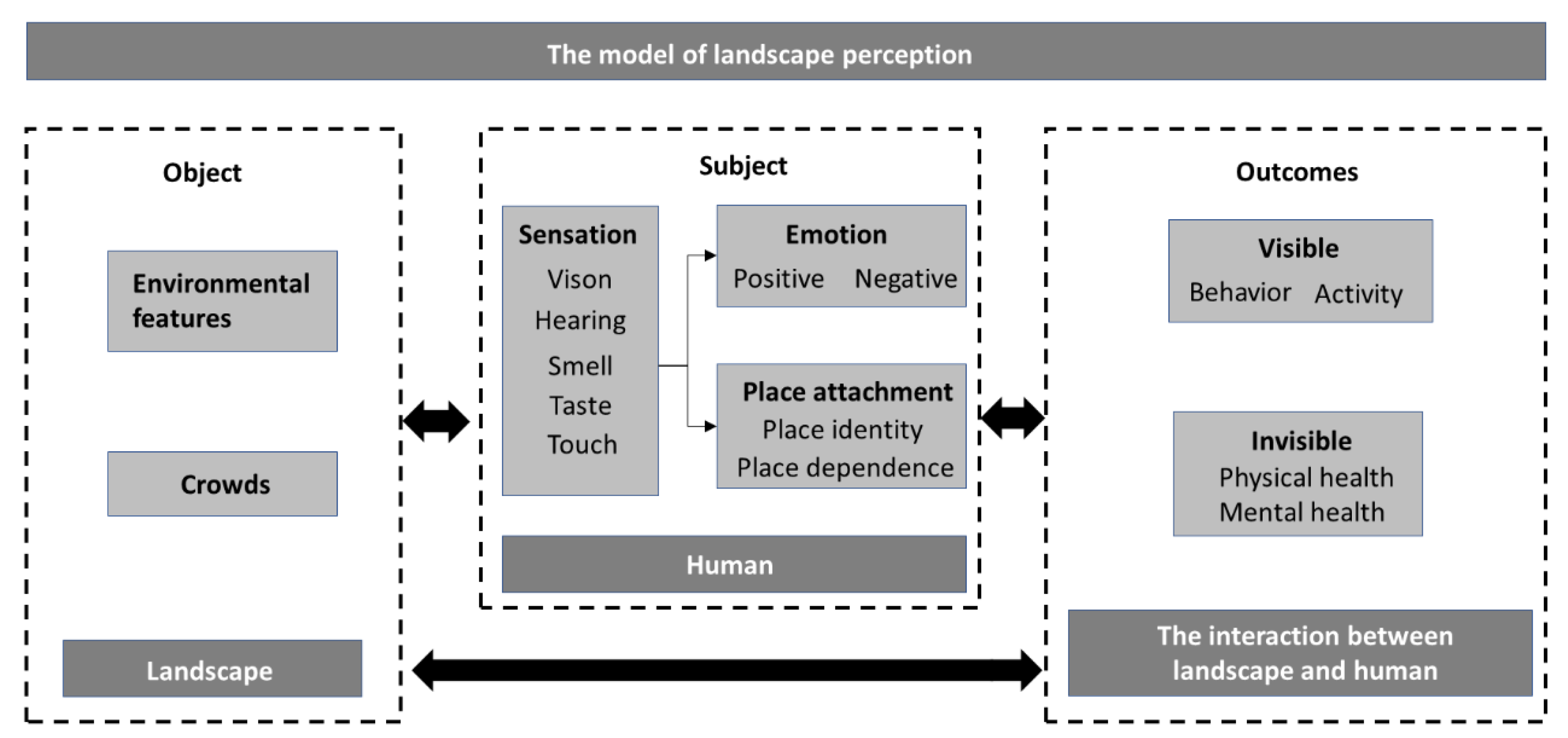
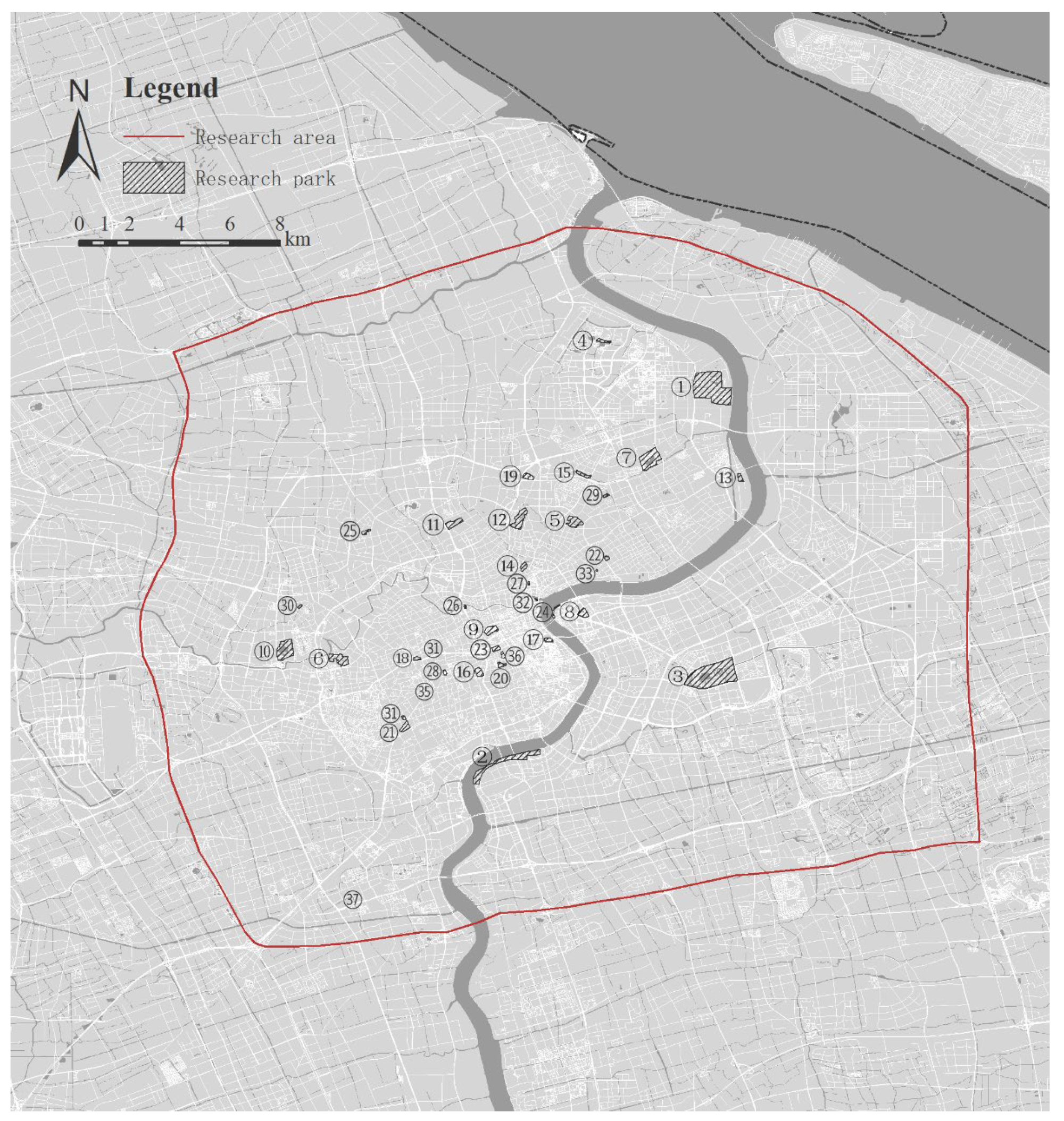
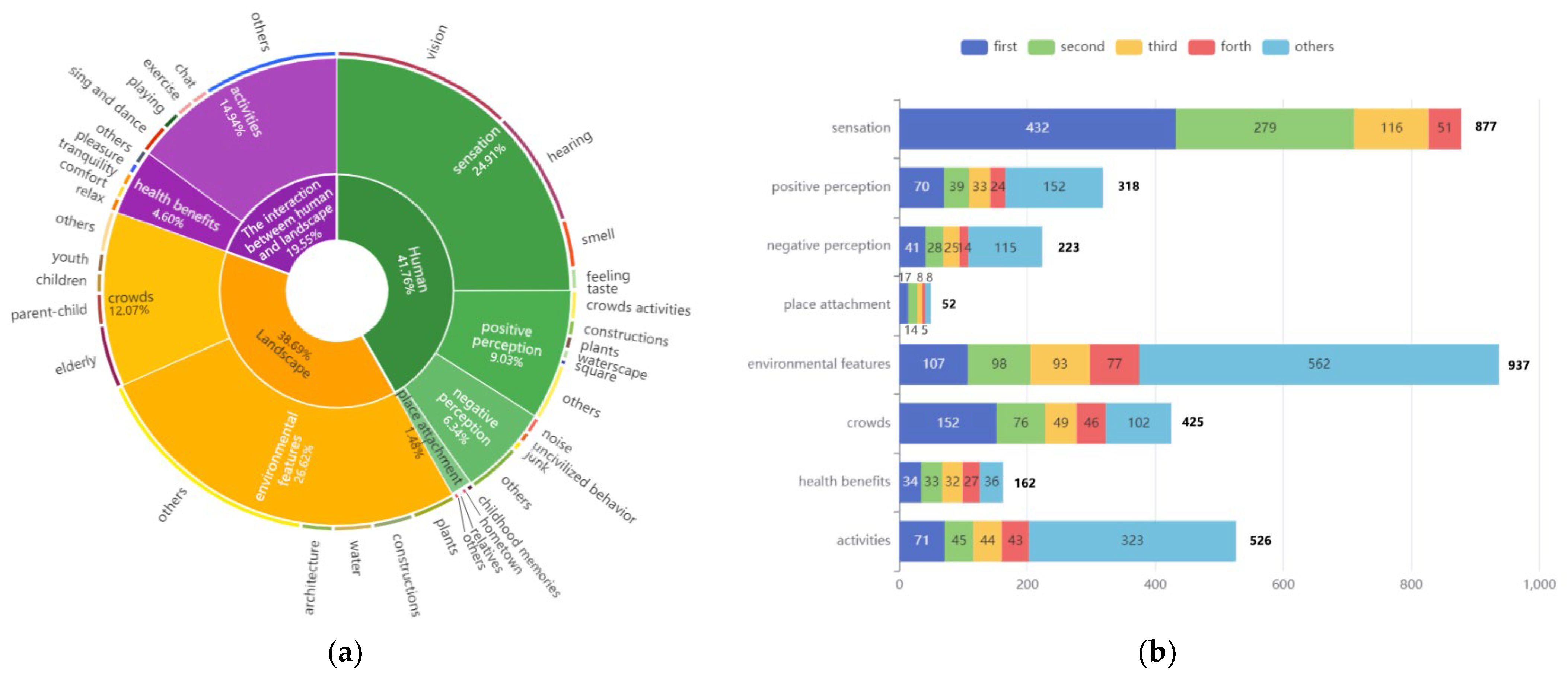
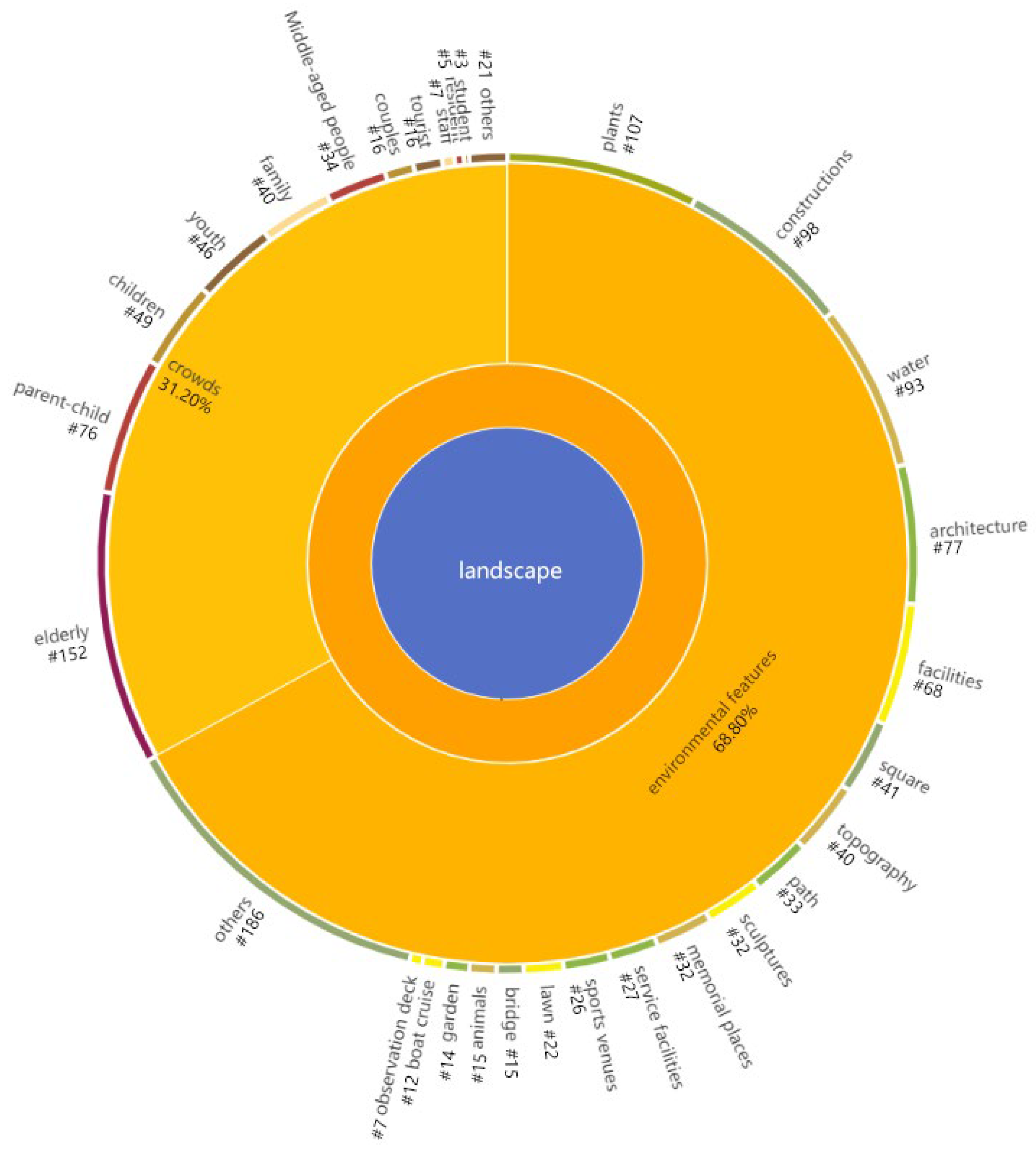
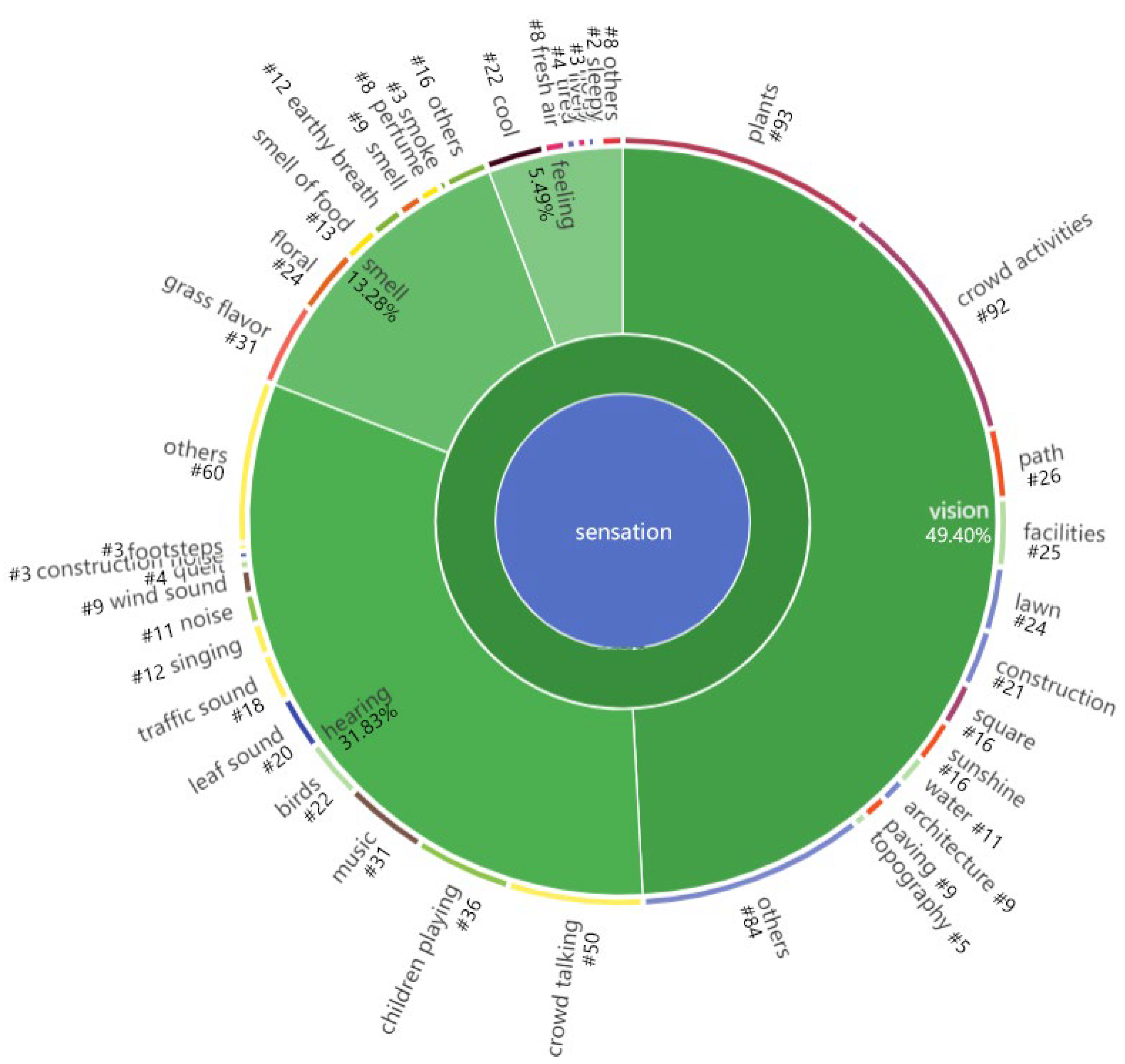
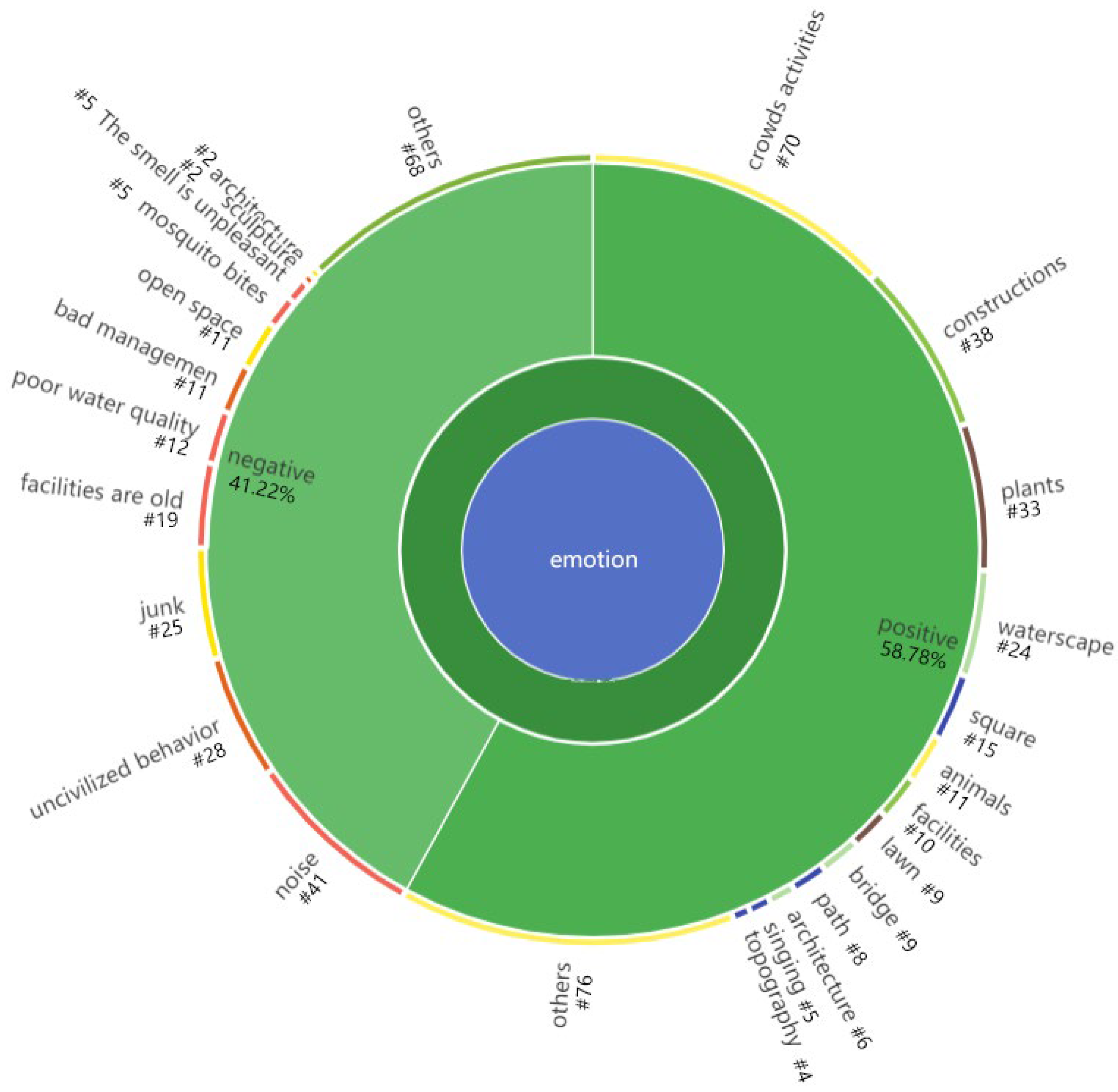

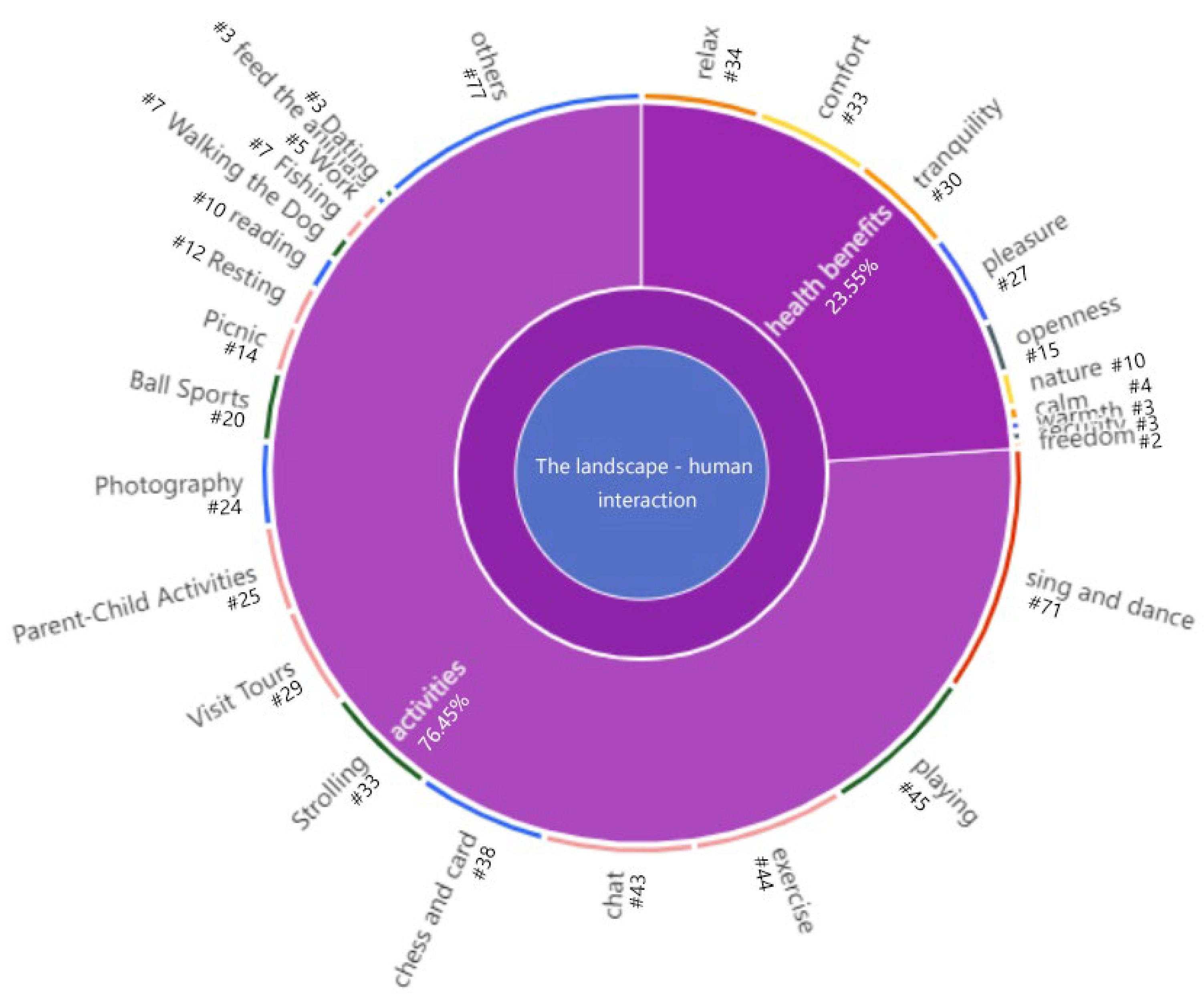
| Class | Serial Number | Park Name | Area | Park Features |
|---|---|---|---|---|
| City park | 1 | Gongqing Forest Park | 131 ha | National forest park |
| 2 | Expo Park | 200 ha | Expo culture | |
| 3 | Century Park | 140.3 ha | ||
| 4 | SMP Skate Park | 14.7 ha | Sports park | |
| 5 | Peace Park | 17.6 ha | ||
| 6 | Zhongshan Park | 20 ha | ||
| 7 | Huangxing park | 40 ha | ||
| 8 | Lujiazui Central Green Space | 10 ha | ||
| 9 | People’s Park | 35.1 ha | ||
| 10 | Changfeng Park | 36.4 ha | ||
| 11 | Zhabei Park | 13.7 ha | ||
| 12 | Lu Xun Park | 28.6 ha | History and cultural park | |
| Regional park | 13 | Fuxing Island Park | 4.2 ha | |
| 14 | North Sichuan Road Park | 4.2 ha | ||
| 15 | Siping Science and Technology Park | 7.0 ha | ||
| 16 | Fuxing Park | 8.9 ha | History and cultural park | |
| 17 | Ancient City Park | 4.0 ha | History and cultural park | |
| 18 | Jing’an Park | 3.4 ha | Sculpture | |
| 19 | Quyang Park | 6.5 ha | ||
| 20 | Taipingqiao Park | 4.4 ha | ||
| 21 | Xujiahui Park | 8.5 ha | History and cultural park | |
| 22 | National Anthem Memorial Square | 2.7 ha | ||
| 23 | Yanzhong Green Space | 3.5 ha | ||
| 24 | Pudong Riverside Park | 8.0 ha | Riverside park | |
| 25 | Ganquan Park | 3.2 ha | ||
| Community park | 26 | Jiuzi Park | 0.5 ha | Cultural and educational park |
| 27 | Kunshan Park | 0.3 ha | ||
| 28 | Xiangyang Park | 2.2 ha | ||
| 29 | Pinehurst Park | 1.4 ha | ||
| 30 | Lancashire Park | 1.3 ha | Youth culture | |
| 31 | Hengshan Park | 1.2 ha | ||
| 32 | Chinese Park | 0.4 ha | ||
| 33 | Huoshan Park | 0.4 ha | Cultural and educational park | |
| 34 | Suzhou Road Children’s Park | 0.5 ha | Children’s park | |
| 35 | Urumqi Road Children’s Park | 0.5 ha | Children’s park | |
| 36 | Huaihai Park | 1.5 ha | Cultural and educational park | |
| 37 | Xuhui Jiachuan Road Garden | 0.5 ha |
| Respondent Characteristics | N (Total n = 349) | Percent |
|---|---|---|
| Sex | ||
| Male | 94 | 26.9% |
| Female | 255 | 73.1% |
| Age | ||
| 19 | 13 | 3.7% |
| 20 | 169 | 48.4% |
| 21 | 98 | 28.1% |
| 22 | 62 | 17.8% |
| 23 | 6 | 1.7% |
| 24 | 1 | 0.3% |
| Country of birth | ||
| China | 347 | 99.4% |
| others | 2 | 0.6% |
| Participation year | ||
| 2014 | 34 | 9.7% |
| 2015 | 54 | 15.5% |
| 2016 | 44 | 12.6% |
| 2017 | 45 | 12.9% |
| 2018 | 68 | 19.5% |
| 2019 | 48 | 13.8% |
| 2020 | 56 | 16.0% |
| How to visit | ||
| Alone | 220 | 63.0% |
| With partner | 129 | 37.0% |
| Daily park user | ||
| Y | 91 | 26.1% |
| N | 258 | 73.9% |
| Dimension | Classification | ||
|---|---|---|---|
| Landscape | Recognizable attractions and elements in the park | Recognizable crowds in the park | |
| Human | What you saw, heard, smelled, and felt | What you like and dislike | Elements relate to developing the place attachment |
| The human–landscape interaction | The activities and behaviors you take part in | The description of health and wellbeing | |
| Dimension | # | % | Theme | # | % | Rank | Code | # |
|---|---|---|---|---|---|---|---|---|
| Human | 1470 | 41.76% | Sensation | 877 | 24.91% | First | Vision | 432 |
| Second | Hearing | 279 | ||||||
| Third | Smell | 116 | ||||||
| Forth | Feeling | 51 | ||||||
| Others | Taste | 0 | ||||||
| Positive perception | 318 | 9.03% | First | Crowd activities | 70 | |||
| Second | Constructions | 39 | ||||||
| Third | Plants | 33 | ||||||
| Forth | Waterscape | 24 | ||||||
| Others | Others | 152 | ||||||
| Negative perception | 223 | 6.34% | First | Noise | 41 | |||
| Second | Uncivilized behavior | 28 | ||||||
| Third | Junk | 25 | ||||||
| Forth | Bad management | 14 | ||||||
| Others | Others | 115 | ||||||
| Place attachment | 52 | 1.48% | First | Childhood | 17 | |||
| Second | Hometown | 14 | ||||||
| Third | Relatives | 8 | ||||||
| Forth | Historical figures | 5 | ||||||
| Others | Others | 8 | ||||||
| Landscape | 1362 | 38.69% | Environmental features | 937 | 26.62% | First | Plants | 107 |
| Second | Constructions | 98 | ||||||
| Third | Water | 93 | ||||||
| Forth | Architecture | 77 | ||||||
| Others | Others | 562 | ||||||
| Crowds | 425 | 12.07% | First | Elderly | 152 | |||
| Second | Parent–child | 76 | ||||||
| Third | Children | 49 | ||||||
| Forth | Youth | 46 | ||||||
| Others | Others | 102 | ||||||
| The human—landscape interaction | 688 | 19.55% | Health benefits | 162 | 4.60% | First | Relax | 34 |
| Second | Comfort | 33 | ||||||
| Third | Tranquility | 32 | ||||||
| Forth | Pleasure | 27 | ||||||
| Others | Others | 36 | ||||||
| Activities | 526 | 14.94% | First | Sing and dance | 71 | |||
| Second | Playing | 45 | ||||||
| Third | Exercise | 44 | ||||||
| Forth | Chat | 43 | ||||||
| Others | Others | 323 | ||||||
| Total | 3520 |
| Trees and Plants | Water | Artificial Landscape |
|---|---|---|
| The greenery gave respondents two completely different experiences: quiet and open. “compared to the quiet and far-reaching green space … this green space is more open …” (Respondent No. 321) | Respondents believe that water is aesthetically pleasing “ water is the most praiseworthy for this park.…as if a few more steps and we are at the water’s edge again.” (Respondent No. 315) | Structures make for a rich spiritual experience “There is a small house … reflects the meaning of “a great hermit in the city …” (Respondent No. 319) |
| The greenery at the lake gives respondents a sense of security. “the taller trees behind the chairs … give people a sense of shelter.” (Respondent No. 94) | Water features make park users feel tranquil and comfortable “There are many waterside landscapes … which makes people feel a classical mood.” (Respondent No. 331) | Seats, scenic walls, and other facilities also have a strong appeal “What attracted my attention is that the square’s scenery is curved…” (Respondent No. 309) |
| Tree roots left a deep impression on respondents “There is also a deep memory of the riverside under the trees… feeling the ups and downs brought about by the interlocking roots, wonderful and intimate.” (Respondent No. 336) | Wang Yulu likes the lake and mentions the security of the mountains “I like the lake and the many trees next to it… a good place is “by the mountains and water” is true.” (Respondent No. 339) | For Yaoqi Zhang, who loves skateboarding, the buildings and structures that provide the venue are necessary “… I think the soul of the skatepark is the structures that provide the skatepark” (Respondent No. 8) |
| Plants also provide rich colors “Many flowering shrubs are planted along the riverbank, which also adds diverse colors along the way.” (Respondent No. 214) | The open lake makes people feel comfortable “I am very pleased when facing the open lake, with the beauty of the view…” (Respondent No. 195) | The park’s amusement facilities are also popular with youth “… I was still attracted by the top of the rotating swings in the playground.” (Respondent No. 339) |
| Crowd Activities | Natural Landscape | Artificial Landscape |
|---|---|---|
| The image of family members together in harmony and warmth is also very attractive to the participants “A family of three, sitting on a boat… the child smiled, the family smiled, this scene is very harmonious, very happy. “ (Respondent No. 329) | The water features surprised participants, “…The spatial experience of the whole environment is very surprising, and the architecture and plants match naturally and harmoniously.” (Respondent No. 1) | Many participants mentioned liking the view and activity attributes of the square ”Spring Square is my favorite landscape area” (Respondent No. 43) |
| Respondents believe that seeing different people and activities is the main reason they like urban parks “I always feel that seeing these different attributes of people gathered here, walking, chatting, doing their own little things, is something very firework. Thus, I like parks in the city.” (Respondent No. 339) | Many participants clearly expressed their love for various water features. “One of the major features of the garden is its water, and the whole garden is tied up with water to string together various views.” (Respondent No. 224) | Respondents love the pavilion and the elderly there and think of their own relatives as a result. “The thing that attracts me most is the pavilion on the hill…the elderly need a space or a place to meet old friends, and this pavilion is a good medium. It reminds me of my own grandparents.” (Respondent No. 316) |
| Hometown | Childhood Memory | Relatives |
|---|---|---|
| The leisurely activities in the park caused respondents to cherish their hometown “… I was reminded of my hometown, a frontier town in a third-tier city, whose peace and calmness is cherished.” (Respondent No. 315) | The park made respondents seem to go back to his childhood memories “When I sat down…my first thought was as if I had gone back to the park I used to go to in my childhood” (Respondent No. 321) | Respondents will be happy when he thinks of their relatives in a park “If there is a park like this near my home, my grandparents must be very happy. They can dance, play chess and chat with their old friends every day” (Respondent No. 316) |
| The rich atmosphere of the park makes respondents, who are studying abroad, feel like he has returned to their hometown. “I felt a very strong sense of life, which made me feel as if I was back in my childhood hometown” (Respondent No. 329) | The current park scene reminds respondents of the space where he first played as a child. “the place where I first played as a child was like the lawn… It’s a pity that I don’t have the same heart and partners.” (Respondent No. 326) | The opera heard in the park made Respondents recall their grandfather “Listening to the old man play the erhu and sing the Qin cadence…I recalled the sound of her grandfather…” (Respondent No. 99) |
| Stress Relief | Attention Restoration | Restorative Perception | Social Cohesion |
|---|---|---|---|
| The park makes respondents feel relaxed physically and mentally. “… there is a sense of ease while leaving the noise. The lake was calm, … and the body and brain were very relaxed.” (Respondent No. 315) | The park allows respondents to experience a quiet atmosphere. “…I felt as if the outside world’s hustle and bustle was isolated, I can feel only the mysterious quiet atmosphere with birdsong.”(Respondent No. 321) | Respondents saw that her favorite kites caused childhood memories and happiness. “…kites have always been associated with happy times in childhood…I looked at them to re-experience the happiness as a child. “ (Respondent No. 240) | Respondents feel happy and at ease when being part of the activities in this field. “…when I am part of the activities on this field …it is lively and the happy atmosphere comes over me and makes me feel at ease in this field.” (Respondent No. 316) |
| Stress can be relieved by looking into the park. “Looking into the distance is very relaxing for both body and mind, and it is not what you see but the scene you see.” (Respondent No. 318) | Anxiety and tiredness were restored in the park. “This park makes people feel at ease, and my restless and tired mind can be relieved here.”(Respondent No. 10) | Respondents’ minds gained peace in their favorite environment. “… quietly feeling the wetness of the grass…. At that time, my heart gained a lot of peace.” (Respondent No. 138) | After interacting with the children, many respondents were very happy. “Feeding the pigeons and interacting with the children was very happy and joyful.” (Respondent No. 94) |
| “highly tense nerves finally relaxed at the moment.” (Respondent No. 10) | “The whole atmosphere is peaceful and calm, with happiness and quietness of years.” (Respondent No. 332) | “ My memories of such places are always sweet and fragrant… remind me of the amusement parks of my early childhood.” (Respondent No. 339) | Talking with friends can be very relaxing. “It’s very relaxing to talk with friends, naturally and eloquently.” (Respondent No. 310) |
| Theme | Finding | Measures | Category |
|---|---|---|---|
| Environmental feature/emotion | Prefer nature | Create beautiful water features, plants, and other natural landscapes. | Landscape environment creation |
| Sensation | Richer in diversity | Pay more attention to creating soundscape and smellscape in parks. | |
| Health benefit | Dynamic and static are equally account | Offer the possibility of social interaction and solitude at the same time. | |
| Activity/emotion | Concern for behavioral activity | Promote parks’ ability to accommodate activities. | Park activities planning |
| Environmental feature/activity | Prefer dynamic and exercise | Provide more dynamic sports and recreational facilities for young adults’ demand. | |
| Crowds/place attachment | Concern for memories of childhood | Provide more family or parent-child activities to resonate with young adults easily. | |
| Emotion/activity | Dislike bad behavior | Make more initiatives to control uncivilized behavior. | Park management |
| Emotion | Focus on sanitation issues | Deal with unhygienic problems to keep the environment tidy. | |
| Emotion/sensation | Sensitive to noise | Reduce noise annoyance through good layout and noise management. |
Publisher’s Note: MDPI stays neutral with regard to jurisdictional claims in published maps and institutional affiliations. |
© 2022 by the authors. Licensee MDPI, Basel, Switzerland. This article is an open access article distributed under the terms and conditions of the Creative Commons Attribution (CC BY) license (https://creativecommons.org/licenses/by/4.0/).
Share and Cite
Dai, D.; Bo, M.; Zhou, Y. How Do the Young Perceive Urban Parks? A Study on Young Adults’ Landscape Preferences and Health Benefits in Urban Parks Based on the Landscape Perception Model. Int. J. Environ. Res. Public Health 2022, 19, 14736. https://doi.org/10.3390/ijerph192214736
Dai D, Bo M, Zhou Y. How Do the Young Perceive Urban Parks? A Study on Young Adults’ Landscape Preferences and Health Benefits in Urban Parks Based on the Landscape Perception Model. International Journal of Environmental Research and Public Health. 2022; 19(22):14736. https://doi.org/10.3390/ijerph192214736
Chicago/Turabian StyleDai, Daixin, Mingyang Bo, and Youmei Zhou. 2022. "How Do the Young Perceive Urban Parks? A Study on Young Adults’ Landscape Preferences and Health Benefits in Urban Parks Based on the Landscape Perception Model" International Journal of Environmental Research and Public Health 19, no. 22: 14736. https://doi.org/10.3390/ijerph192214736
APA StyleDai, D., Bo, M., & Zhou, Y. (2022). How Do the Young Perceive Urban Parks? A Study on Young Adults’ Landscape Preferences and Health Benefits in Urban Parks Based on the Landscape Perception Model. International Journal of Environmental Research and Public Health, 19(22), 14736. https://doi.org/10.3390/ijerph192214736





